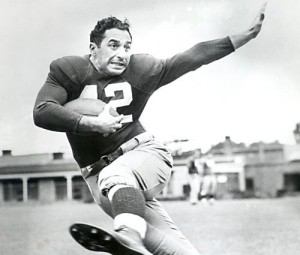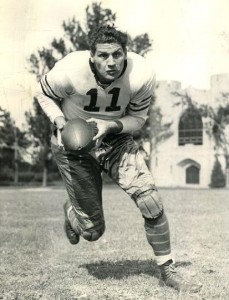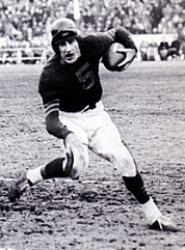Remembering the NFL on December 7, 1941
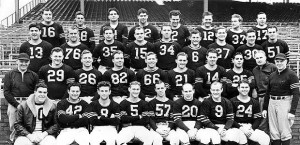
The 1941 Chicago Bears defeated the Chicago Cardinals 34-24 on December 7, 1941 and then went on to win the NFL Championship. Many members of the Bears went on to serve in the military during World War II.
In remembrance of the 70th anniversary of “A day that will live in infamy”, we look back at the final day of the 1941 National Football League regular season and how the Japanese attack of Pearl Harbor nearly half a world away forever changed the lives of many of the players who were on the field that afternoon.
In 1941 the National Football League was not quite the national phenomenon it is today. On the final Sunday of the NFL season, December 7, 1941, there were only three games on tap and the games were not preceded by hours of pre-game shows and wall-to-wall television coverage.
Instead, they were available only to those fortunate enough to have a ticket for the games in Chicago, New York or Washington or for those listening to one of the broadcasts on radio.
Of the three games, only one, the city rivalry between the Chicago Bears and Chicago Cardinals, had implications on the upcoming post season. The other two games, the New York Giants (who had already clinched a spot in the league championship game) against the Brooklyn Dodgers and the Philadelphia Eagles facing the Washington Redskins, were about pride and finishing the season on a positive note.
Word of the attacks started to spread while all three games were in action and the public address announcers at the Polo Grounds in New York and Comiskey Park in Chicago interrupted the game to tell all servicemen to report to their units. At Griffith Stadium in Washington the announcer paged high-ranking government and military personnel at the game, but did not mention the attack.
Nearly 1,000 past, current or future NFL players and personnel served in the U.S. Military during World War II (check out the full list). Through their unique stories we learn the true meaning of personal sacrifice as many either never returned to the NFL or missed what would have been the prime of their career while serving their country.
While the story of every American veteran is unique and important, a capsule of the shared sacrifice and implications of World War II can be learned by looking at 10 men who were part of the pivotal Bears-Cardinals game on December 7, 1941. Many of them would be part of very different (and much more important) battles just months later.
Chicago Bears at Chicago Cardinals – Comiskey Park
Under the guidance of head coach George Halas, the Chicago Bears entered their game against the Chicago Cardinals with a 9-1 record and needing a victory to tie the Green Bay Packers for the NFL’s West Division title. The Cardinals were 3-6-1 on the season and were completing their fourth straight losing season.
The afternoon did not start well for the Bears as the Cardinals raced to an early 14-0 lead. However, second quarter touchdown runs by Norm Standlee and Joe Maniaci tied the game before a field goal by Bill Daddio gave the Cardinals a surprising 17-14 halftime lead.
An 18-yard touchdown run by Hugh Gallarneau put the Bears back in the lead, but the Cardinals answered early in the fourth quarter when Ray Mallouf connected with Bert Johnson on a 26-yard touchdown pass to make the score 24-21 in favor of the Cardinals.
However, the upset was not to be. Future Hall of Famers Sid Luckman and Geroge McAfee connected on a 39-yard scoring pass and then McAfee broke free for a 70-yard run to seal the 34-24 victory for the Bears.
Bill Davis: The first touchdown of the game was scored by probably one of the least likely players to accomplish such a feat, Bill Davis. A second-year tackle who had been chosen by the Cardinals in the 11th round of the 1940 NFL Draft, the Texas Tech product scored on a fumble recovery to give the Cardinals an early lead. The 1941 season finale would turn out to be his final game with the Cardinals as he left the NFL to serve in World War II. He did manage to play eight games for the Brooklyn Dodgers in 1943 and then after the war played one season in the AAFC for the Miami Seahawks.
Marshall Goldberg: The second touchdown for the Cardinals was scored on a six-yard run by third-year running back Marshall Goldberg. A former standout at the University of Pittsburgh, Goldberg was emerging as an NFL standout in 1941 as he was named to the Pro Bowl for the first time while leading the league in all-purpose yardage.
Goldberg remained with the Cardinals in 1942 (leading the league in kickoff return yardage) and then played in one game in 1943 before spending two years in the Navy, reaching the rank of Lieutenant.
He rejoined the Cardinals in 1946 and the following season helped lead the team to their only NFL Championship. However, his production on offense never regained its pre-war level and by his final season in 1948 he was used almost exclusively on defense.
Goldberg was named to the College Football Hall of Fame in 1958, but though he has twice been considered as a finalist for the Pro Football Hall of Fame still does not have a bust in Canton.
After football, Goldberg worked in insurance and then operated a machine tool company. Following his death in 2006, his family set up The Marshall Goldberg Traumatic Brain Injury Fund at the University of Chicago to look at the implications of head injuries suffered by athletes.
Norm Standlee: The 6-2, 238 pound bruising fullback and linebacker Norm Standlee had been the first round draft choice of the Chicago Bears in 1941 out of Stanford. His touchdown against the Cardinals was the fifth of his rookie season and he finished the season with 414 yards rushing while intercepting two passes.
He combined with George McAfee, Bill Osmanski and Hugh Gallarneau to give the Bears an unstoppable backfield behind quarterback Sid Luckman and seemed destined to follow in the great Chicago Bears tradition of legendary stars including Red Grange, Bronko Nagurski, Bill Hewitt and George Musso.
That destiny seemed even more likely after Standlee scored twice in each of their playoff victories over the Packers and Giants to win the 1941 NFL Championship.
However, Standlee left the Bears to serve in World War II and would never again wear a Chicago uniform.
After serving in World War II, Standlee joined the San Francisco 49ers of the fledgling AAFC and spent seven seasons as a fullback and linebacker.
He rushed for a career-high 651 yards in 1946 and the following season scored eight rushing touchdowns. Later in his career Standlee was used primarily on defense.
In 1950, the first year the 49ers were part of the NFL, Standlee earned Pro Bowl honors as a linebacker.
Had World War II not wiped away four years and the chance for Standlee to play for the NFL’s most storied franchise, it is certainly possible that his career might have ended with a bust in Canton. Instead, he passed away in 1981 and has been largely forgotten across the NFL.
Joe Maniaci: A tough fullback who had played his college football at Fordham, Maniaci scored the second touchdown for the Bears to tie the game at 14-14. It would prove to be the final touchdown of his six year NFL career.
Originally drafted by the Brooklyn Dodgers in the sixth round of the 1936 draft, Maniaci spent two full seasons with the Dodgers before going to the Bears midway through the 1938 season.
In Chicago he developed into an important component of their offensive machine, rushing for a career-high 544 yards in 1939 and earning Pro Bowl honors in 1940.
With a plethora of backs in 1941, Maniaci’s opportunities on offense were reduced and he carried the ball only 28 times during the season. However, he was still a valuable player on defense and was successful on all eight of his extra point attempts as a kicker.
Maniaci entered the military following the season and would never again play in the NFL.
After the war, he served two seasons as the head football coach at St. Louis University before the school dropped football following the 1949 season. He also served as an assistant coach for the Philadelphia Eagles. He passed away in 1996.
Hugh Gallarneau: A teammate of Standlee on the undefeated 1940 Stanford squad that won the Rose Bowl, Gallarneau gave the Bears a short-lived lead with his third quarter touchdown to make the score 21-17. Also a rookie in 1941, Gallarneau had been chosen in the third round of the NFL draft and gave the Bears additional depth in their running game.
Though he ranked fourth on the team with 304 yards rushing, Gallarneau led the league with 8 rushing touchdowns and was named to the Pro Bowl. He also returned an interception for a touchdown during the season.
In 1942 Gallarneau was part of the Bears squad that finished the regular season 11-0 before losing in the NFL Championship Game to the Washington Redskins.
Following the 1942 season, Gallarneau joined the Marine Corps and served in the Pacific Theatre. He rose to the rank of Major and was a member of the Air Warning Squadron during the Battle of Okinawa.
He returned to the Bears for the 1945 season and in 1946 rushed for a career-high 476 yards as the Bears won the NFL Championship.
After retiring from the NFL in 1947, Gallarneau stayed in the Chicago area and worked for a number of companies. He was inducted into the College Football Hall of Fame in 1982 and passed away in 1999.
Ray Mallouf: Early in the fourth period, the Cardinals regained the lead when rookie quarterback Ray Mallouf connected with Bert Johnson on a 26-yard touchdown pass.
A 10th round draft pick in 1941 out of SMU, Mallouf moved into the lineup for the Cardinals midway through his rookie season and completed 50% of his passes for 725 yards and two touchdowns.
Mallouf joined the U.S. Navy following Pearl Harbor and did not return to the NFL until the 1946 season.
He served as the punter and backup quarterback for the Cardinals in 1946 and 1947 as the team won the 1947 NFL Championship. In 1948 he was the starting quarterback for much of the season as the Cardinals went 11-1 and reached a second straight NFL Championship Game.
Mallouf passed for a career-high 1,160 during the season, but in a snowy blizzard in Philadelphia could complete only 3-of-7 passes for 35 yards as the Cardinals lost to the Eagles 7-0.
That was the final game for Mallouf with the Cardinals as he spent the 1949 season as the punter and backup quarterback with the New York Giants.
He passed away in 2008 at the age of 89.
George McAfee: Though only in his second season in the NFL in 1941, McAfee was already emerging as a superstar when he took over the game against the Cardinals in the final minutes.
First, McAfee caught a pass from Sid Luckman and went 39 yards to put the Bears back in front. Later, he sealed the victory with a 70-yard touchdown scamper.
The second pick in the 1940 NFL Draft out of Duke University, McAfee announced his presence in the NFL by returning a punt 75 yards to win the first exhibition game in which he played for the Bears.
Favorably compared to all-time great Red Grange, McAfee was a multi-dimensional threat. In 1941 he was a first team All-Pro while rushing for 474 yards and interception six passes. During the season, he scored on a 70-yard run, 74-yard punt return, 97-yard kickoff return, 39-yard pass reception and 43-yard interception return.
Following Pearl Harbor, McAfee joined the Navy and didn’t return to the NFL until 1945.
Though he was never again the same player as he was in 1941, McAfee was a productive player for the Bears from 1945-1950 and helped the team win the 1946 NFL Championship. For his career, McAfee averaged 4.9 yards per rush attempt, 12.8 yards per punt return, 27.8 yards per kick return and intercepted 25 passes.
He was inducted into the Pro Football Hall of Fame in 1966 and passed away in 2009 at the age of 90.
Sid Luckman: The 1941 season proved to be the breakout season for third year star quarterback from Columbia, Sid Luckman. Though he was the signal-caller when the Bears romped past the Washington Redskins to win the 1940 NFL title, it was in 1941 that he illustrated the ability to be an elite quarterback.
Luckman completed 57.1 percent of his passes for 1,181 yards, nine touchdowns and six interceptions as the Bears again claimed the NFL title.
After leading the Bears to an undefeated regular season in 1942, Luckman joined the U.S. Merchant Marines in 1943. However, because he was originally stationed stateside, he was able to participate in games for the Bears in 1943 and tossed a career-high 28 touchdowns while leading the Bears to the NFL title.
He was later assigned to a tanker carrying gasoline to Europe and during the invasion of Normandy in June 1944 he was on a transport ferrying troops from Britain to France.
Luckman played in only seven games in 1944, but returned to full NFL duties after the war and played with the Bears through the 1950 season.
He completed his career with 14,686 career passing yards, 137 touchdowns and a 51.8 completion percentage. Luckman was inducted into the Pro Football Hall of Fame in 1965. He passed away in 1998 at the age of 81.
Young Bussey: A popular college quarterback at LSU, Bussey was an NFL long-shot as he was chosen by the Bears in the 20th round of the 1940 NFL draft. He served as the backup to starting quarterback Sid Luckman in 1941, but also emerged as a standout defensive player.
Bussey completed only 13 of his 40 pass attempts in 1941, but made the most of them accounting for 353 yards and five touchdowns. He also had two pass interceptions.
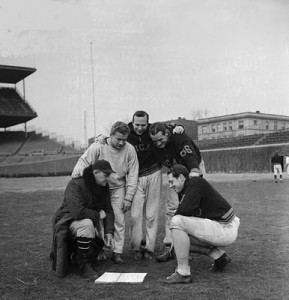
Young Bussey (second from left) and fellow Bears Bob Snyder, Ken Kavanaugh, and Dick Plasman confer with head coach George Halas (far left).
What would prove to be the final action of Bussey’s NFL career occurred in the Pro Bowl on January 4, 1942 when he connected with Ken Kavanaugh for the final Chicago touchdown as the Bears defeated the NFL All-Stars 35-24 at the Polo Grounds.
Bussey soon joined the Navy and reached the rank of Lieutenant. He was killed during the Battle of Lingayen Gulf in January 1945.
His story was chronicles in the book: Young Bussey, Young Stud.
George Halas: Even the patriarch of the NFL was called into duty during World War II. After leading the Bears to the 1941 NFL Championship and a 5-0 start to the 1942 season, Halas left the Bears to serve in the Navy as a Lieutenant Commander responsible for welfare and recreational activities for the seventh fleet.
Halas previously had served as an ensign during World War I.
In World War II he received the Bronze Star and left the Navy in 1946 as a Captain.
He returned to the Bears in 1946 and led them to the NFL Championship. He would ultimately win 318 NFL games as a coach and six NFL Championships.
Beginning in 1946 and lasting for the next 25 years, the Bears annually hosted a benefit game for the armed forces that raised over $1.2 million dollars. In 1956 he was awarded the Distinguished Public Service Medal, which is the Navy’s highest civilian honor.
He passed away in 1983 at the age of 88. The George Halas Trophy is annually awarded to the winner of the NFC Championship Game.
POST SCRIPT: A total of 23 NFL players or front office personnel were killed during World War II. You can read about their heroics at coldhardfootballfacts.com.
In addition to Bussey, among those who were killed was New York Giants end Jack Lummus, who was awarded the Congressional Medal of Honor following his death at Iwo Jima, and Green Bay Packers guard Howard “Smiley” Johnson, who was also killed at Iwo Jima and received the Gold Star.
Also killed at Iwo Jima was former Chicago Cardinals coach and Notre Dame player Jack Chevigny. It was Chevigny who scored the winning touchdown for Notre Dame during the famous “win one for the Gipper” game against Army.
Though he never played in the NFL, another notable football great who died during World War II was 1939 Heisman Trophy winner Niles Kinnick. After being chosen by the Brooklyn Dodgers in the second round of the 1940 NFL Draft, Kinnick instead went to the University of Iowa Law School. He enlisted in the Navy three days before Pearl Harbor and was training to be a fighter pilot when killed during a training flight in 1943.
We will never truly be able to quantify the valor or sacrifices that were made by all men and women who served to protect our most precious freedoms during World War II. As we celebrate the 70th anniversary of Pearl Harbor, it is important to remember their stories and sacrifices. While most of these national heroes are no longer with us in body, their spirit of patriotism and honor must never be forgotten.
